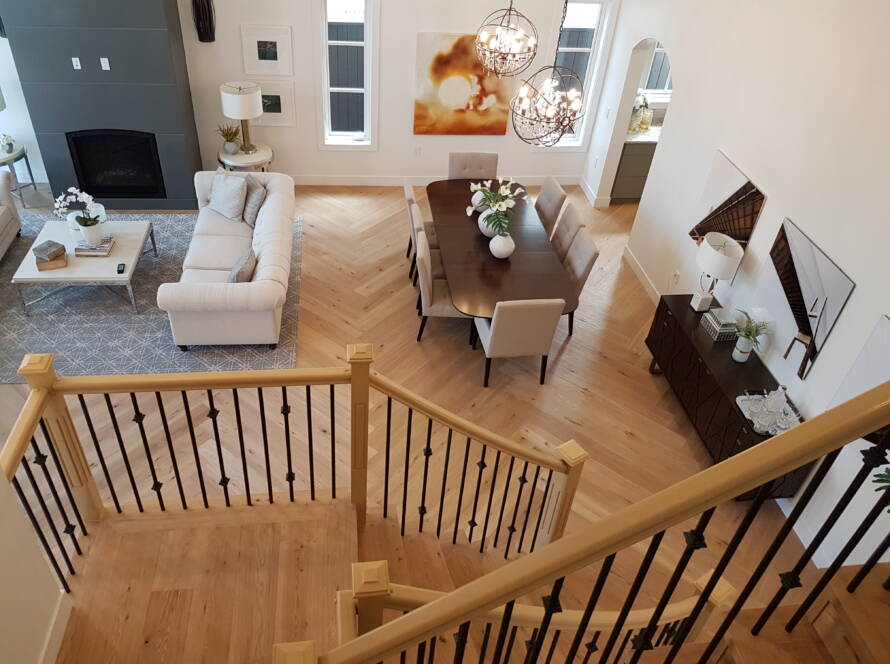INTRODUCTION
Homeowners, flooring professionals, builders, architects, property managers, strata representatives can all get caught up in disputes over noise complaints in both new and existing homes.
Understanding the details is key to setting expectations and correctly setting expectations is key to avoiding so many of the complaints that happen.
When out shopping for a new floor, we are often led to believe that a new floor covering installed in combination with an acoustical underlayment (that advertises a high sound rating) will prevent noise complaints.
This is not necessarily the case.
This is not necessarily the case. The underlayment itself contributes very little to sound suppression in comparison to that of the overall building design.
Meanwhile, many flooring underlayment products (i.e. cork, rubber, foam, fabric) are seen as a fix-all to the problem of noise in buildings. Many go the easy route and claim high sound ratings (labelled IIC and STC, explained later) but don’t guarantee they will deliver those ratings in your home or multi-family building. Noise complaints and law suits are often the result.
Just because an underlay product comes with a high sound rating does not mean it will deliver that same rating in your building or home. Why?
An acoustical rating can only be associated with a floor ceiling assembly including all its components. You need to take into consideration that acoustically rated underlayments can be tested in conditions that are favorable for noise reduction, for example, in a laboratory setting over solid concrete with a ceiling design that further helps to suppress sound transference. Together, these factors ensure a simple underlay scores a high acoustical rating due to test conditions that are not likely to exist in your buildings design.
Test standards matter. Acoustical testing of products includes everything in the building design between your living space and the living space above you; ceiling assembly, subfloor, underlay and floor covering (hardwood, laminate, etc.)
In the following pages, we will look at some of the details that are commonly misunderstood.
TWO COMMON TYPES OF CONSTRUCTION
Will a flooring underlay with an IIC of 84 prevent neighbors from hearing each other? Absolutely not.
The design of a building and its subfloor is the most important factor when it comes to preventing noise transfer between suites. Design can change from building to building. High-rise towers have solid concrete subfloors that are usually 6″ thick. Concrete buildings rely on the quality of the slab and the underlayment that will be chosen. Wood frame buildings will have many components to take into consideration that will have an impact on the overall performance.
The diagrams below show two common scenarios. Click here for a video demonstrating impact noise in a typical wood frame construction building.
Figure 1 shows concrete high-rise slab construction with no ceiling assembly.
Figure 2 shows wood frame construction with a 1 ½” acoustical topping and dropped ceiling assembly.


As a homeowner, these details are important to understand when purchasing an acoustically rated underlay for your new flooring project, or as a strata council when writing bylaws to guide homeowners correctly and fairly, or as a developer, architect or builder designing structures that are comfortable to live in
TWO CATEGORIES OF SOUND
- Noise generated by an impact of some kind such as footsteps and dropped objects.
- Noise related to ambient sounds such as voices, pets, a TV or music from a radio.
HOW ARE PRODUCTS TESTED FOR SOUND SUPPRESSION?
There are two classes of measurement that determine how much a sound generated in a test is reduced as it travels through a building’s substructure between levels and/or through walls. They are:
- Impact Insulation Class (IIC) – Noise caused by impact. Footsteps, dropped objects, etc.
- Sound Transmission Class (STC) – The sound of voices, music, TV etc.
DIFFERENT TEST STANDARDS FOR ACOUSTICAL PRODUCTS
What test standard was your acoustical underlayment tested in accordance with?
You may have seen reference to IIC and STC ratings on a number of different products.
What does this mean? Not much if the product doesn’t also state which testing standard was used to produce those IIC/STC ratings. IIC ratings of 60, 70, 80+ are meaningless without a test standard.
Tests recognized by industry are produced by an independent body called ASTM International.
ASTM International – Is an independent standards body that designs and publishes numerous testing standards used in multiple industries across North America. For example, there are several test standards published by ASTM that address various acoustical scenarios used to measure sound transmission in buildings. For a full list of test standards click here.
For example, two common test standards that appear on underlayment specifications are:
For Impact Insulation Class (IIC)
- ASTM E492 – Standard Test Method for Laboratory Measurement of Impact Sound Transmission Through Floor-Ceiling Assemblies Using the Tapping Machine
For Field Sound Transmission Class (FSTC)
- ASTM E-90 Standard Test Method for Laboratory Measurement of Airborne Sound Transmission Loss of Building Partitions and Elements
HOW DO YOU DEAL WITH NOISE ISSUES?
What are the best ways to deal with these issues and to suppress noise between living spaces and/or neighbors? There are no magic solutions here, however, the level of noise traveling through a building is dependent on a number of factors (listed below):
a. Architectural design and construction of the building’s subfloor and ceiling components
Designing buildings with sound suppression in mind starts well before construction. Effective methods to interrupt sound waves passing through building materials must be planned and budgeted for in advance.
As a home owner who is sensitive to this issue, buy a suite with no neighbors above; research the building design and ask if there were sound barriers built into the design.
b. Lifestyle of the building occupants
The sounds experienced when living below a retired couple versus a young family of four can be vastly different. A change of neighbours above is often the trigger for a noise complaint.

c. Manage Your Expectations
Buyer beware. When buying a new home, if you move into a space beneath another family’s home, expect noise. Noise will travel laterally like sound waves do along a tuning fork. TV sounds, for example, may travel upwards and across and not necessarily come from where you think.
d. Floor Covering Type
Carpet flooring being soft helps to muffle noise generating impacts. Harder surface flooring (laminate, wood, vinyl) creates a different noise when walked on with shoes. A change in floor coverings (from soft to hard surface for example) can highlight pre-existing lifestyle characteristics. Area rugs are often used effectively to suppress noise creation.
e. Floor Covering Underlayment’s such as Cork, Rubber, and High-Density Foam Sheets
Underlayments installed beneath floor covering products can assist in reducing noise transfer. However, the level of effectiveness may not meet your expectations. Before you determine what to use, understand the basics of product acoustical testing, sound ratings. This will help to set your expectations.
WHAT SHOULD STRATA COUNCILS AND PROPERTY MANAGEMENT COMPANIES DO?
New Installations and Strata Bylaws
If a new flooring installation causes a complaint you can order a floor covering installation inspection to help confirm that the floor covering was installed correctly and in compliance with the strata by-laws.
If you want to measure how the building elements are performing with regards to sound suppression between floors, you will need to contact an acoustical engineer.
Set expectations – Noise is a fact of life in single family homes and multi-family buildings. Sound travels through building materials. If you are in the market to buy a new or existing condo for example, then the advice is ‘buyer beware’. Neighbors living above change, lifestyles change, old carpet that is quiet to live on gets replaced with harder flooring products that don’t muffle sound in the same way.
For this reason, strata bylaws may include statements like, ‘cover new hard surface flooring with a minimum of 60% area rugs in high traffic areas’.
WHAT UNDERLAYMENT IS RECOMMENDED?
The short answer is that the best acoustical underlay is the one that works for you and your unique situation. Consider your budget, your subfloor, your building’s design, the type of floor you’re installing and of course, your strata. All must work together to achieve success.
The long answer is that there is no single “best underlay.” Every underlay is the “best” for one reason or another. One may be inexpensive, making it the best for somebody on a budget, while another may be extra soft underfoot, making it the “best”. One underlay may be described as having an added moisture barrier, which may be the “best” for your concrete subfloor, while another may not have a built-in moisture barrier, making it the “best” for plywood subfloors. Then there is the “best” underlays for acoustics. These underlays all claim to have outstanding sound absorption qualities, and some may actually do a decent job, but the “best” underlay is ultimately the one that your strata approves…and that may not be the “best” underlay at all! Always keep in mind to have context of the performance in which floor ceiling assembly will be installed.
DISCLAIMER
Note that this information is for general guidance only. NFCA accepts no liability for decisions made based on the information provided and always recommends consulting with experts specifically trained to deal with acoustical issues. Such resources include but are not limited to acoustical engineers, legal experts, property manager, acoustical product manufactures etc.
For full article and videos please visit: https://www.nfca.ca/education-calendar/acoustical-issues/


